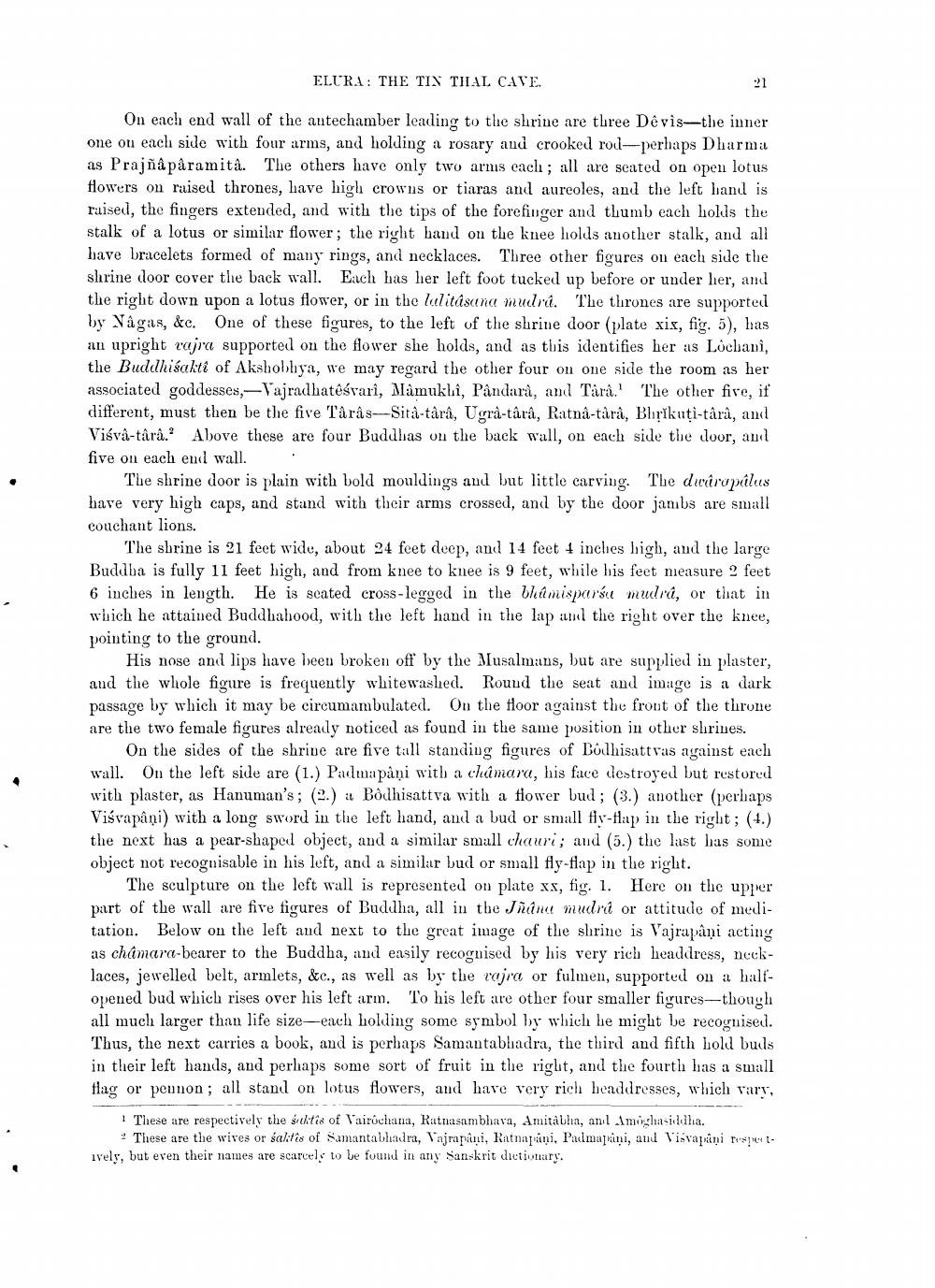________________
ELURA: THE TIX THAL CAVE.
On each end wall of the antechamber leading to the shrine are three Dévis-the inner one on each side with four arms, and holding a rosary and crooked rod-perhaps Dharma as Prajña paramita. The others have only two armis cach; all are seated on open lotus flowers on raised thrones, have high crowns or tiaras and aureoles, and the left hand is raised, the fingers extended, and with the tips of the forefinger and thumb each holds the stalk of a lotus or similar flower; the right hand on the knee holds another stalk, and all have bracelets formed of many rings, and necklaces. Three other figures on each side the shrine door cover the back wall. Each has her left foot tucked up before or under her, and the right down upon a lotus flower, or in the lulitásuna mudra. The thrones are supported by Vagas, &c. One of these figures, to the left of the shrine door (plate xix, fig. 5), has an upright vajra supported on the flower she holds, and as this identifies her as Lochani, the Buddhisakti of Akshobhya, we may regard the other four on one side the room as her associated goddesses, -Vajradhateśvari, Mamukli, Påndara, and Tara.' The other five, if different, must then be the five Târâs--Sità-tåra, Ugra-tårå, Ratna-tårå, Bhrikuti-tårà, and Visva-tara.? Above these are four Buddhas on the back wall, on each side the door, and five on each end wall.
The shrine door is plain with bold mouldings and but little carving. The dwûropålus have very high caps, and stand with their arms crossed, and by the door jambs are small couchant lions.
The shrine is 21 feet wide, about 24 feet deep, and 14 feet 4 inches high, and the large Buddba is fully 11 feet high, and from knee to knee is 9 feet, while his feet measure 2 feet 6 inches in length. He is scated cross-legged in the blamispars mudra, or that in which he attained Buddhahood, with the left hand in the lap am the right over the knee, pointing to the ground.
His nose and lips have been broken off by the Musalmans, but are supplied in plaster, and the whole figure is frequently whitewashed. Round the seat and image is a dark passage by which it may be circumambulated. On the floor against the front of the throne are the two female figures already noticed as found in the same position in other shrines.
On the sides of the shrine are five tall standing figures of Bodhisattvas against each wall. On the left side are (1.) Padma påņi with a chamara, his face destroyed but restored with plaster, as Hanuman's; (2.) a Bodhisattva with a flower bud; (3.) another (perhaps Viśvapâni) with a long sword in the left hand, and a bud or small fiv-Hap in the right; (4.) the next has a pear-shaped object, and a similar small chauri; and (5.) the last has some object not recognisable in his left, and a similar Lud or small fly-flap in the right.
The sculpture on the left wall is represented on plate xs, fig. 1. Here on the upper part of the wall are five figures of Buddha, all in the Jnana mudre or attitude of meditation. Below on the left and next to the great image of the shrine is Vajrapâņi acting as châmara-bearer to the Buddha, and easily recognised by his very rich headdress, necklaces, jewelled belt, armlets, &c., as well as by the vajra or fulmen, supported on a halfopened bud which rises over his left arm. To his left are other four smaller figures--though all much larger than life size-each holding some symbol by which he might be recognised. Thus, the next carries a book, and is perhaps Samantabhadra, the third and fifth bold bulls in their left hands, and perhaps some sort of fruit in the right, and the fourth has a small flag or pennon; all stand on lotus flowers, and have very rich headdresses, which varv,
1 These are respectively the suktis of Vairóchana, Ratnasambhava, Amitabha, anılmoghasiddha.
These are the wives or saltis of Samanta bhadra, Vajrapani, Ratnapani, Padmajini, and Visvaprini respuesta ively, but even their names are scarcely to be found in any Sanskrit dictionary.




